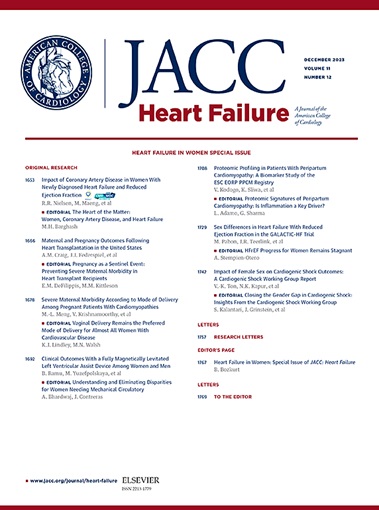Risk Factors and Temporal Trends of Maternal Heart Failure
IF 11.8
1区 医学
Q1 CARDIAC & CARDIOVASCULAR SYSTEMS
引用次数: 0
Abstract
Background
Maternal heart failure (HF) is increasing in several countries, but trends in Sweden remain unclear. The extent to which changes in maternal risk factors contribute to this trend and the proportion of cases linked to associated cardiac conditions are not well established.
Objectives
The purpose of this study was to estimate the annual incidence of maternal HF in Sweden over the last 2 decades, assess the proportion with associated cardiac disease, identify risk factors, and examine whether changes in risk factor prevalence explain temporal trends.
Methods
National cohort study comprising 2,078,384 deliveries to women without pre-existing cardiac disease registered in the Swedish Medical Birth Register (2000-2019). Cases of maternal HF, with and without associated cardiac disease, were identified through linkage with national patient and mortality register. Annual incidence rates were calculated, stratified by pregnancy- or postpartum-onset and cardiac disease status. Multivariable logistic regression was used to assess risk factors.
Results
Maternal HF increased by 66% over the study period, with an overall incidence of 0.34 cases per 1,000 deliveries (95% CI: 0.30-0.38). Associated cardiac disease was present in approximately one-half of cases. Identified risk factors included prepregnancy comorbidities and pregnancy complications. The rising incidence was partly, yet not fully, explained by changes in risk factor prevalence.
Conclusions
The increasing incidence of maternal HF in Sweden highlights a growing clinical concern. The high prevalence of associated cardiac disease underscores the need for heightened awareness and appropriate management of affected patients.
产妇心力衰竭的危险因素和时间趋势
背景:在一些国家,产妇心力衰竭(HF)正在增加,但瑞典的趋势尚不清楚。产妇危险因素的变化在多大程度上促成了这一趋势,以及与相关心脏疾病有关的病例所占比例尚不清楚。目的本研究的目的是估计过去20年瑞典产妇HF的年发病率,评估与心脏相关疾病的比例,确定危险因素,并检查危险因素流行率的变化是否解释了时间趋势。方法:国家队列研究,包括2000-2019年在瑞典医疗出生登记处登记的2,078,384名无既往心脏病的分娩妇女。通过与国家患者和死亡率登记的联系,确定了伴有或不伴有相关心脏病的产妇心衰病例。计算年发病率,按妊娠或产后发病和心脏病状况分层。采用多变量logistic回归评估危险因素。结果在研究期间,产妇HF增加了66%,总发病率为每1000次分娩0.34例(95% CI: 0.30-0.38)。在大约一半的病例中存在相关的心脏病。确定的危险因素包括孕前合并症和妊娠并发症。发病率上升的部分原因是危险因素流行率的变化,但不是全部原因。结论:瑞典产妇心衰发病率的上升引起了越来越多的临床关注。相关心脏病的高流行率强调需要提高对受影响患者的认识和适当管理。
本文章由计算机程序翻译,如有差异,请以英文原文为准。
求助全文
约1分钟内获得全文
求助全文
来源期刊

JACC. Heart failure
CARDIAC & CARDIOVASCULAR SYSTEMS-
CiteScore
21.20
自引率
2.30%
发文量
164
期刊介绍:
JACC: Heart Failure publishes crucial findings on the pathophysiology, diagnosis, treatment, and care of heart failure patients. The goal is to enhance understanding through timely scientific communication on disease, clinical trials, outcomes, and therapeutic advances. The Journal fosters interdisciplinary connections with neuroscience, pulmonary medicine, nephrology, electrophysiology, and surgery related to heart failure. It also covers articles on pharmacogenetics, biomarkers, and metabolomics.
 求助内容:
求助内容: 应助结果提醒方式:
应助结果提醒方式:


